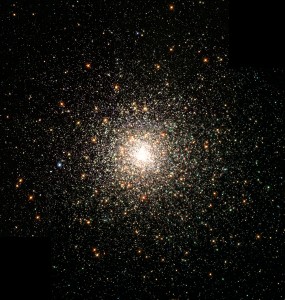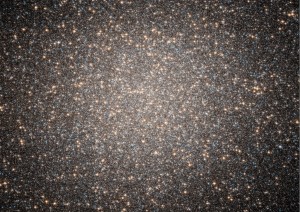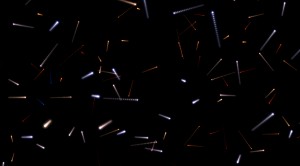
Scattered around the periphery of our galaxy, the Milky Way, are upwards of 150 odd creatures called globular clusters. They’re little agglomerations of stars that are bound by gravity into a sphere and that inside it, are buzzing around like flies. They’re odd because 1) most stars come in singles or pairs, and globulars have hundreds, maybe thousands, maybe millions of stars – and that quantification alone tells you how much astronomers know about them; and 2) most stars are relatively young; and globulars are so old they set a lower limit on the age of the universe, which after all, can’t be younger than its own stars. What are they doing out there? A famous astronomer told me, “We know zip, I think.”

And if their stars are gravitationally bound, why haven’t they buzzed into their mutual center and made a black hole? Black holes come two general sizes, galaxy-sized and star-sized; why not globular-sized? Theorists thought it likely. So two observers at the Space Telescope Science Institute used the Hubble Space Telescope’s ability to resolve the hairs on God’s head, and mapped the stars in the globular called Omega Centauri (Alpha Centauri is the brightest star in the constellation, Centaurus; Omega is obviously on the other end of the alphabetical brightness scale) twice, four years apart. In effect, they made a a very short, two-frame stop-action movie and found, they wrote, “no need to invoke [a black hole] in Omega Cen at all.”
 Rats. For some reason – maybe they didn’t want to waste that nice little movie, maybe they just think globulars are beautiful — they did some physics and projected the star’s motions 10,000 years into the future. Here’s a picture and they’re right, these things are beautiful; make of it what you will.
Rats. For some reason – maybe they didn’t want to waste that nice little movie, maybe they just think globulars are beautiful — they did some physics and projected the star’s motions 10,000 years into the future. Here’s a picture and they’re right, these things are beautiful; make of it what you will.
Credits:
M80: AURA/ STScI/ NASA
Omega Centauri: NASA, ESA, STScI/AURA
Omega Cen in 10,000 years: NASA, ESA, J. Anderson, R. van der Marel, & G. Bacon (STScI)
I love that last picture, and especially the colors, but still wonder if the color is human person imposed as in a touched up photograph or if this is how they look when you look through the Hubble Telescope.
I also looked at their article. How did you decipher all that math, especially given what I know of your education in math?
That last picture is a simulation so the colors are whatever was fed into the computer. But your question is still good: almost all astro pictures are taken with film sensitive to certain colors or filters that let in or keep out certain colors, and then those films and filters are combined so that the pictures has all the colors. That sounds onerous but I think they do it because the colors our eyes can see are such a puny small number of all the colors (wavelengths) these things shine in. If that makes sense.
I didn’t look at the math in that article, only the setup and the payoff. I’d complain that you’re running down my math abilities but my math abilities can’t be run down.
I too downloaded that article. Blimey, as we say over here. That must be the longest ever formulation of the expression “dunno”.
Has to be something to do with this dark matter, or dark energy stuff I keep reading about.
Good grief, I hope it doesn’t have anything to do with the dark sector. It’s complicated enough without that. I love that phrase, “dark sector.” Ask Richard, he’s got a book coming out about it.